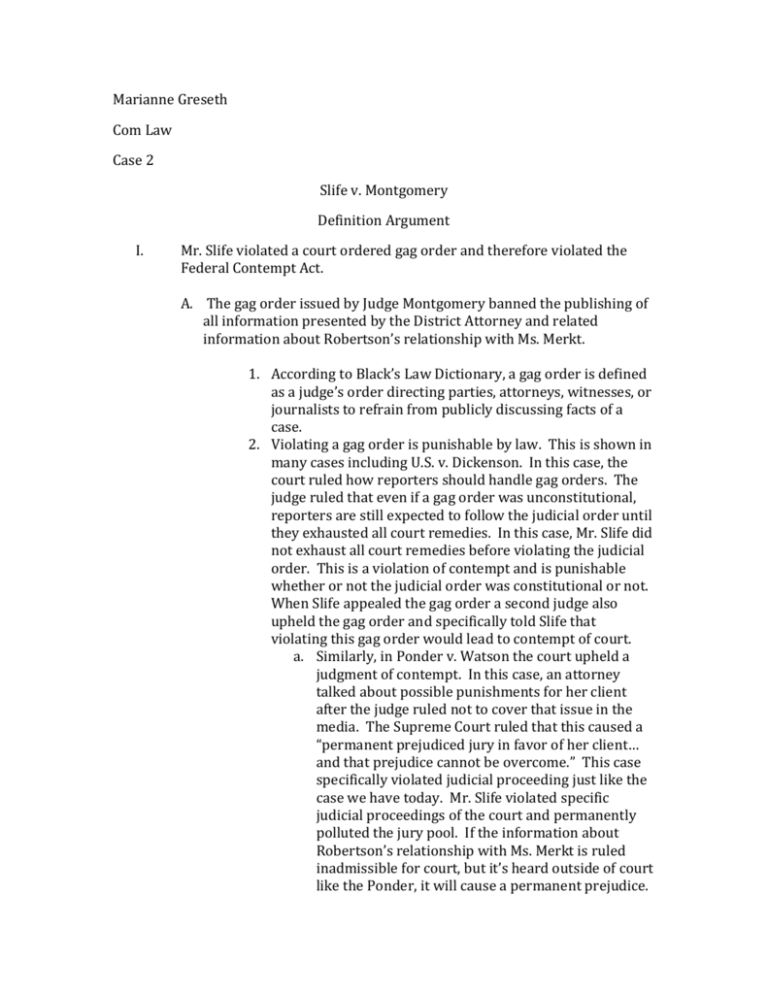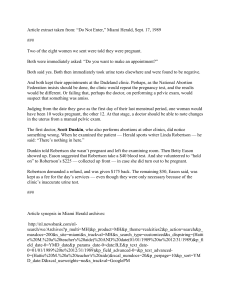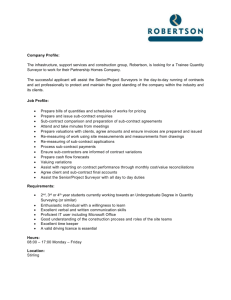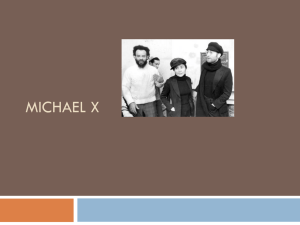com law case 2 - mariannegreseth
advertisement

Marianne Greseth Com Law Case 2 Slife v. Montgomery Definition Argument I. Mr. Slife violated a court ordered gag order and therefore violated the Federal Contempt Act. A. The gag order issued by Judge Montgomery banned the publishing of all information presented by the District Attorney and related information about Robertson’s relationship with Ms. Merkt. 1. According to Black’s Law Dictionary, a gag order is defined as a judge’s order directing parties, attorneys, witnesses, or journalists to refrain from publicly discussing facts of a case. 2. Violating a gag order is punishable by law. This is shown in many cases including U.S. v. Dickenson. In this case, the court ruled how reporters should handle gag orders. The judge ruled that even if a gag order was unconstitutional, reporters are still expected to follow the judicial order until they exhausted all court remedies. In this case, Mr. Slife did not exhaust all court remedies before violating the judicial order. This is a violation of contempt and is punishable whether or not the judicial order was constitutional or not. When Slife appealed the gag order a second judge also upheld the gag order and specifically told Slife that violating this gag order would lead to contempt of court. a. Similarly, in Ponder v. Watson the court upheld a judgment of contempt. In this case, an attorney talked about possible punishments for her client after the judge ruled not to cover that issue in the media. The Supreme Court ruled that this caused a “permanent prejudiced jury in favor of her client… and that prejudice cannot be overcome.” This case specifically violated judicial proceeding just like the case we have today. Mr. Slife violated specific judicial proceedings of the court and permanently polluted the jury pool. If the information about Robertson’s relationship with Ms. Merkt is ruled inadmissible for court, but it’s heard outside of court like the Ponder, it will cause a permanent prejudice. II. The violation of the gag order by Mr. Slife will cause imminent danger to Mr. Robertson. A. Black’s Law Dictionary defines imminent danger as an immediate, real threat to one’s safety that justifies the use of force in self-defense. Similarly, danger is defined as peril or exposure to harm. Mr. Robertson will be in imminent danger if reporters are allowed to report on Robertson’s relationship with or reaction to the actions of Ms. Merkt involving Robertson. Judge Montgomery said this information would inflame the community and an inflamed community would put Robertson in an immediate danger and threat to his safety. B. In KPNX v. Arizona Superior Court the court upheld a gag order in a case similar to this one. In KPNX the judge made a gag order to keep all court personnel from speaking with reporters. It was a murder trial just like this one and Judge Rehnquist ruled that communication between court personnel and the press could cause a serious problem for a fair trial. In this case, the judge balanced the fair trial rights of defendants with the rights of reporters. This is what needs to happen in the case today. Mr. Robertson’s right to a fair trial outweighs the medias right to cover a relationship. Slife v. Montgomery Value Argument I. Violating the gag order has an adverse affect on Mr. Robertson. A. Mr. Robertson will not receive a fair trial if the gag order is overturned. 1. Biased jury members will pollute the jury pool a. Black’s Law Dictionary defines objective as being without bias or prejudice. b. In Marshall v. United States the court overturned a conviction because of pretrial publicity. In this case the jurors said they wouldn’t be influenced by information about the defendant published in a newspaper, but the Supreme Court ruled that since the jurors’ heard information that was too prejudicial to be presented as evidence in news accounts that it would be prejudicial for Marshall’s case and a new trial should be granted. This is similar to today’s case. If the news can publish prejudicial information about Robertson then they can’t be free of bias when hearing the case. 2. According to research done by the Department of Psychology at Indiana University and Purdue University, juries exposed to negative pre-trial publicity were more likely to return a conviction than juries who weren’t exposed to negative pre-trial publicity. They also found that most jurors don’t make decisions in the manner the court expects. Decisions are based on past experiences and other perceived information that is seen as relevant to help make a decision. So, even if a judge said disregard all other information you’ve heard about Mr. Robertson in the media. The information they heard would play a part in making their decision to convict or not to convict. Research of human cognition concludes that people can rarely make decisions based on evidence presented; instead they use every relevant data they’ve heard. II. There needs to be a balance between the 6th amendment right to a fair trial for Robertson and the 1st amendment right to free speech. A. Pre judicial pretrial publicity causes an immediate and severe danger for Robertson and his right to a fair trial. 1. In Sheppard v. Maxwell, Sheppard was massacred by media coverage. All but one juror admitted to hearing news coverage before the trial and they continued to hear anti-Sheppard media throughout the trial. Sheppard was convicted of seconddegree murder, but the Supreme Court overturned the conviction on the basis of prejudicial publicity. The court ruled that the judge could have done more to protect Sheppard like insulating witnesses, restricting press at trial, and controlling the release of information. This is an example of what could happen in the Robertson case. Judge Montgomery is being proactive and taking the ruling from this case and applying it to Robertson. He is restricting press and controlling the release of information like the court ruled in the Sheppard case. He is trying to protect Robertson and save the community from having to re-try him at a later date. Prejudicial publicity can have an overwhelming negative affect on jurors. Slife v. Montgomery Objection Argument I. The gag order issued was constitutional A. There was clear wording in the definition of the gag order. 1. There are clear definitions of the words used in the gag order in Black’s Law Dictionary. Words like objective, competent jury, related information, or inflame are all defined. B. The reach of the gag order is narrow. 1. The gag order only involves the issues in this specific case. 2. Reporters can report on other things involved in the case like the judges performance or other court proceedings other than the information presented by the District Attorney and any related information to those facts presented. 3. They can report on the gag ordered specific issues after the case is presented and a verdict is reached. II. Mr. Slife should be convicted of violating the Federal Contempt Act. A. The Federal Contempt Act allows the court to punish disobedience of any judicial procedure in the presence of the court or “so near thereto” as to obstruct the administration of justice. B. In U.S. v. Dickenson the court ruled that all court remedies must be used before violating a gag order. Slife did not do this and therefore should be punished for contempt. Refutation Argument I. My opponent will use Murphy v. Florida, which states that jurors don’t have to be totally ignorant of the background information of the defendant if they can put their impressions aside and make an unbiased verdict. They will use this case to say the reporters can publish background information about Robertson and his past relationships. They will argue that jurors can still have an unbiased opinion even if they know some background information. Rebuttal: I will use the Department of Psychology at Indiana University and Purdue University study that found jurors’ biases always play a role in their decisionmaking. I will also use the research that says jurors use all relevant information to make decisions and therefore the more negative publicity juror’s have heard about Robertson, the more that information will play into their decision. Also, if the media publishes things about Robertson’s past relationships that are inadmissible in court, but the jurors hear them this could cause a mistrial as in Marshall v. United States. Likewise in Shepherd v. Florida the court rule that the press cannot deprive the accused to the right to a fair trial. Robertson should be allowed a fair trial. II. My opponent will use Nebraska Press Association v. Stuart, which says that a judge must show an imminent threat to the administration of justice. They will say that in this case there is no imminent threat to Robertson or the administration of justice. They may say that if the gag order is upheld it could be considered prior restraint, which is a violation of First Amendment rights. Rebuttal: I will say that violating this gag order will be an imminent danger to Robertson. Judge Montgomery said this case could inflame the community causing danger to Robertson. Similarly, a violation will hurt the jury pool and ruin Robertson’s chance at a fair trial. In this case a balance between the right to a fair trial and the right to report need to be balanced. Does the public need to know about Robertson’s relationship with Ms. Merkt to be considered informed? The reporters could report on these details after the jury makes a decision and then still be keeping the public informed of court proceedings? III. My opponent might use the Bridges Principle established in Bridges v. California. This principle uses “clear and present danger” instead of “bad tendency” to test contempt cases. This case gives more power to the press to publish information about court proceedings. They will say that in the Robertson case there isn’t “clear and present danger.” Rebuttal: I will say that the bridges principle applies more to judicial proceedings, court actions, and the legal process not to details of a case. Judge Montgomery put a gag order on the evidence presented by the District Attorney and other information about Robertson’s relationship with Ms. Merkt, not information about himself, the legal process, or other proceedings. The cases that applied the Bridges Principle, Craig v. Harney, Wood v. Georgria, and Pennekamp v. Florida, all sided with the press because the judges tried to ban negative information about themselves and their policies. But, in Ponders v. Watson the court upheld a gag order because the defense attorney published favorable information about her client that caused a prejudiced jury. This is the same as the Robertson case, publishing information about his past will cause a permanently prejudiced jury. IV. They may use Times-Picayune Publishing Corporation v. Schulingkamp to emphasize the point of needing “clear and present danger.” Rebuttal: I will again say there is an imminent danger to Robertson’s right to a fair trial and we need to balance those rights. The right of Robertson’s fair trial with an unbiased jury pool outweighs a reporters right to publish information that could wait until after a verdict is reached.





